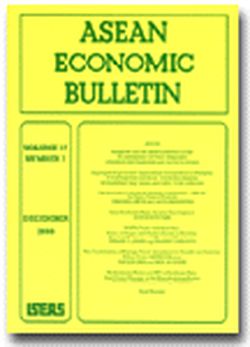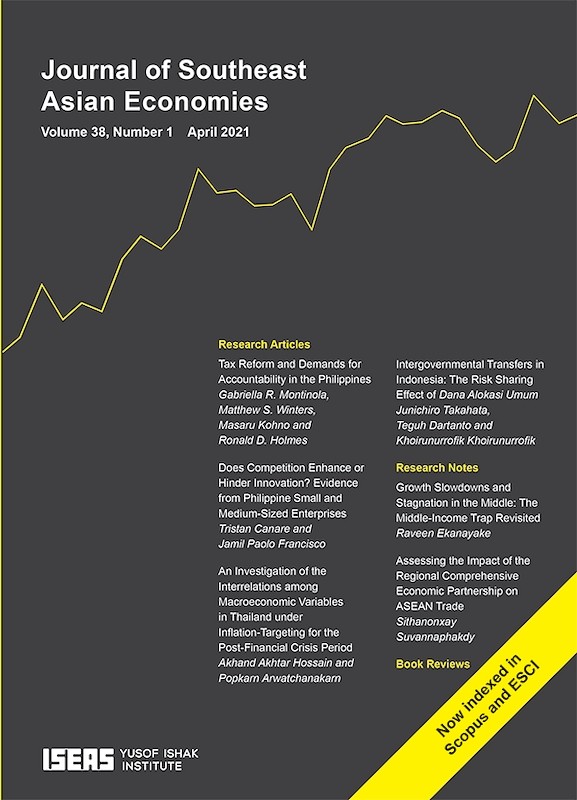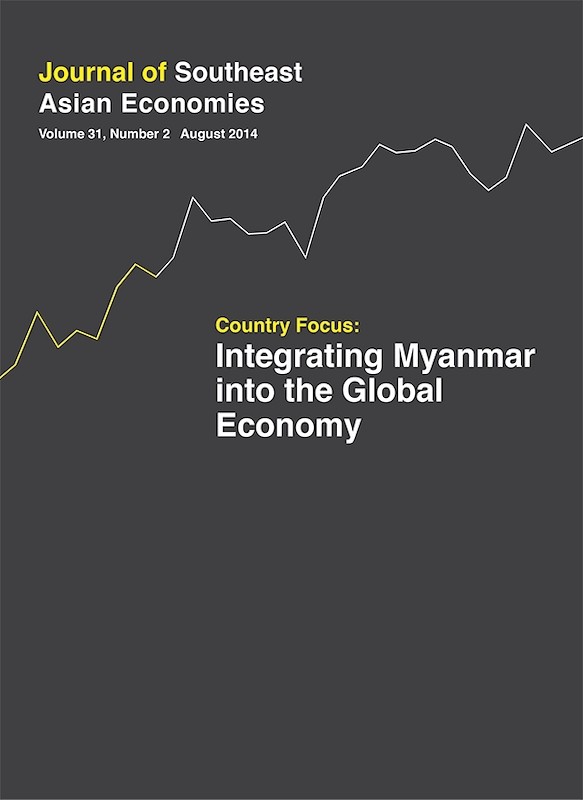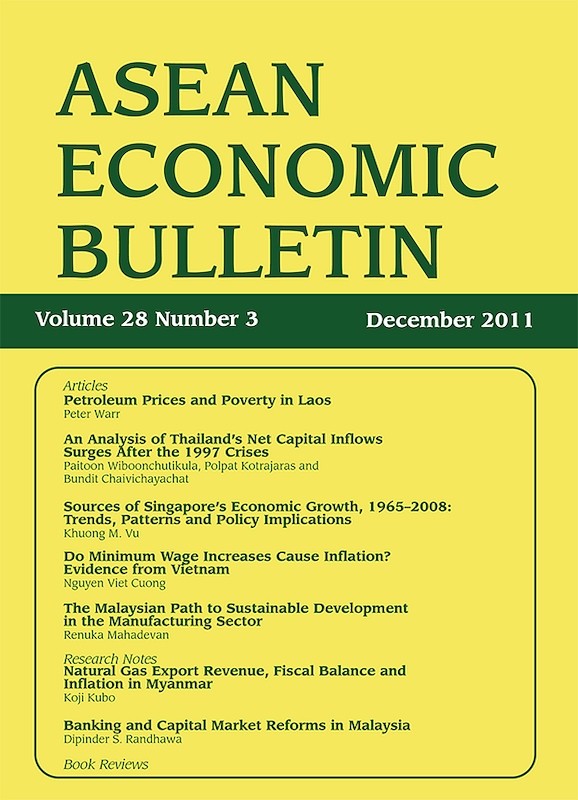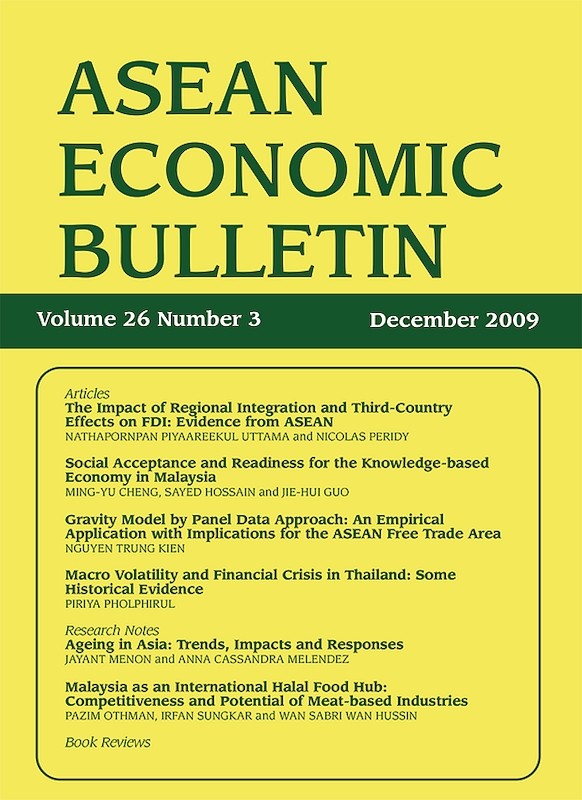ASEAN Economic Bulletin Vol. 21/2 (Aug 2004)

Date of publication:
September 2004
Number of pages:
128
Code:
AE21/2
Contents
-
ASEAN Economic Bulletin Vol. 21/2 (Aug 2004)
-
Preliminary pages
- ARTICLES
-
Comparative Borderland Developments in Thailand, by Chuthatip Maneepong, Chung-Tong Wu, authors see abstractInterest in the development of Asian cross-border zones has burgeoned since the late 1980s and early 1990s after the Cold War period. Thailand and its neighbours are developing economic relationships that naturally started with their respective borderlands. Responding to these possibilities, Thai government agencies, often in conjunction with bilateral or multilateral agencies, designed a number of projects at the Thai border zones with Laos and Malaysia. In spite of similar potential and government investments, these border zones have evolved quite differently. Nongkhai, bordering Laos, the selected government centre, has not fared well, while Sadao, bordering Malaysia, has flourished. The data from this research point to several key factors that have influenced the divergent paths.
-
Impact of Regional Trade Liberalization on Emerging Economies: The Case of Vietnam, by Toh Mun Heng, Vasudevan Gayathri, authors see abstractThis study provides an appraisal of Vietnam's regionalist integration strategy of trade liberalization. Trade liberalization through participation in regional free trade agreement (FTAs), such as the ASEAN Free Trade Area (AFTA) and the planned ASEAN-China Free Trade Agreement (ACFTA), have also provided Vietnam with useful lessons and experience to succeed in its domestic economic reforms. Using computable general equilibrium models, the quantitative impact of different configurations of regional free trade areas on Vietnam is made. The results indicate that further participation in the expansion of FTAs beyond AFTA could bring greater economic advantage and lower adjustment costs for Vietnam's efforts in industrialization and fostering structural economic change.
-
Fertility Transition in South and Southeast Asia, by Anu Rammohan, author see abstractThis paper uses a combination of economic reasoning with empirical evidence to review the fertility decline experienced in South, Southeast, and East Asia. The fertility transition in this region has roughly coincided with a period of rapid economic growth. There has also been an increase in urbanization levels, greater female education and labour force participation, and demand for skilled labour. The paper focuses on the manner in which these macro-level changes have raised the production cost of children as assets and changed parental perception of children from being economic assets to liabilities. Where these factors have not come into play, such as in India, demographic change has not materialized, at least not to the extent of the other countries in this sample.
-
Is There Non-linear Real Exchange Rate Adjustment for the Asian Economies?, by Mark J Holmes, author see abstractThis study tests for non-linearities in the behaviour of U.S. dollar real exchange rates of eleven Asian economies. For this purpose, logistic and exponential smooth transition regression models are applied to quarterly data over the sample period 1973Q22001Q1. There is evidence of non-linearities in the behaviour of four real exchange rates where, in three of these cases, non-linearities are captured by the logistic smooth transition auto-regressive model. The extent of non-linearities varies across Asian countries with India and Singapore exhibiting the sharpest transition between regimes of appreciating and depreciating real exchange rates.
-
Competitive Devaluations -- Bitter Pill or Bad Medicine? The Case of Thailand, by Tracy Yang Su-Chin, Jamus Jerome Lim, authors see abstractDevaluation and crises in emerging economies have tended to be followed by an outright economic collapse. This post-devaluation economic contraction is inconsistent with the conventional view that devaluation is expansionary/inflationary and needs to be accompanied by demand deflationary monetary and fiscal policy. This paper undertakes a detailed empirical analysis to determine whether real devaluation is contractionary rather than expansionary in the case of Thailand, which was the trigger country in the East Asian crisis of 1997-98.
- RESEARCH NOTES
-
The IPS-NTU ASEAN 9 +1 Economic Competitiveness Ranking Indices, by Tan Khee Giap, author
-
Fueling Southeast Asia's Growth: The Energy Challenge, by Andrew Symon, author
- BOOK REVIEWS
-
BOOK REVIEW: The Asian Development Experience: Overcoming Crises and Adjusting to Change, by Seiji F. Naya., by Robert L Curry, Jr., author
-
BOOK REVIEW: Vietnam: A Transition Tiger? by Brian Van Arkadie and Raymond Mallon; The Vietnamese Economy: Awakening the Dormant Dragon, edited by Binh Tran-Nam and Chi Do Pham., by Nick J Freeman, author
-
BOOK REVIEW: The Economy of the Philippines: Elites, Inequalities and Economic Restructuring, by Peter Krinks., by Aladdin D Rillo, author
-
BOOK REVIEW: The Philippine Economy: Development, Policies, and Challenges, edited by Arsenio M. Balisacan and Hal Hill., by Ramonette B Serafica, author
-
BOOK REVIEW: Law and Development in East and Southeast Asia, edited by Christoph Antons., by Rajenthran Arumugam, author

